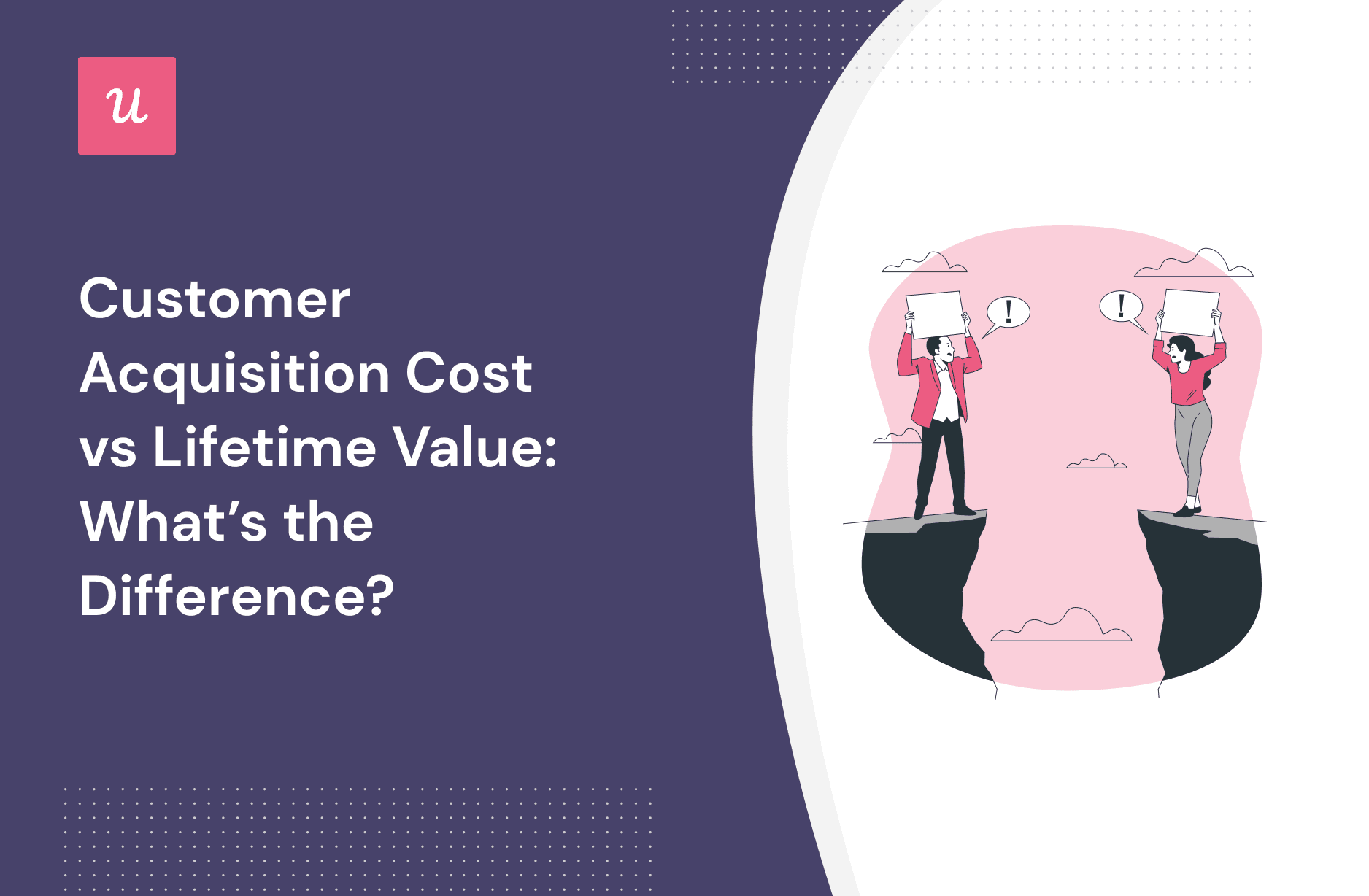
Customer Acquisition Cost vs Lifetime Value: What’s the Difference?
Customer acquisition cost vs lifetime value: which one should you prioritize?
Both these metrics are crucial for getting product growth insights into the financial health and sustainability of your SaaS business. Tracking them allows you to allocate resources effectively and optimize your sales and marketing budget.
But how do they differ from each other? Let’s dive in to find out and also discuss how you can improve both your customer acquisition cost and lifetime value.
Get The Insights!
The fastest way to learn about Product Growth, Management & Trends.
Summary of customer acquisition cost vs lifetime value
- Customer acquisition cost (CAC) is the money a business spends on acquiring new customers.
- Customer lifetime value (LTV) refers to the expected revenue stream from one customer throughout their business with you.
- To measure CAC, divide the total acquisition cost by the number of new customers acquired during a given period.
- Calculate LTV by multiplying the customer value by the average customer lifespan.
- CAC measures costs, whereas LTV gives an estimate of profits.
- The LTV:CAC ratio evaluates the financial health and efficiency of your product marketing and customer acquisition efforts.
- To measure the LTV:CAC ratio, divide the lifetime value by the customer acquisition cost.
- A good LTV:CAC ratio for SaaS businesses is at least 3:1, but it must not be too high.
- Some other key product metrics are customer retention rate, customer churn, average revenue per user, conversion rate, and gross margin.
- To improve your LTV:CAC ratio, personalize user experience from the beginning, offer in-app guidance, drive account expansion, improve secondary onboarding, track user behavior, and collect customer feedback.
What is customer acquisition cost (CAC)?
Customer acquisition cost (CAC) is the money a business spends on acquiring new customers (who purchase its products or services). The metric measures the average cost incurred in acquiring one customer.
CAC allows you to assess the effectiveness and efficiency of your customer acquisition strategies. You can make well-informed decisions about your sales and marketing budget and evaluate the return on investment for acquiring new users.
What is customer lifetime value (LTV)?
Customer lifetime value (LTV) refers to the total revenue a business can earn from a single customer over the entire period of their relationship.
Because SaaS companies rely on monthly recurring revenue instead of single transactions, LTV is critical to increasing customer retention and revenue.
Tracking this metric will help you assess the long-term financial value and profitability of your customer base. It will let you make data-backed decisions about customer acquisition and retention strategies.
How to calculate customer acquisition cost?
To measure customer acquisition cost, you need to divide the total cost of acquisition by the number of new customers acquired during a given period.
The total cost of acquisition includes expenses related to sales and marketing efforts, such as marketing spend, advertising costs, salaries, and other related expenses.
Suppose you spent $100,000 on acquiring customers in 2022 and gained 1,200 new customers by the end of the year. Your CAC for 2022 would thus be = $100,000/1,200 = $83.33.

How to calculate customer lifetime value?
To measure customer lifetime value, you have to multiply the customer value by the average customer lifespan.
Here, customer value equals the average purchase value times the average purchase frequency rate. The average purchase value is the total revenue divided by the number of purchases. In contrast, the average purchase frequency rate is the ratio of the number of purchases to the number of customers.
Suppose your customers spend an average of $100 per purchase, and the average purchase frequency is 4. Now, if the average customer lifespan is 5 years, your LTV would be = $100 x 4 x 5 = $2,000.

Customer acquisition cost vs lifetime value
How is customer acquisition cost different from lifetime value?
CAC measures costs and is more of a definite metric than LTV. On the other hand, LTV is an estimate of profits. It gives the expected revenue generated per customer instead of a definite number.
Ideally, the average lifetime value of the customers should exceed the acquisition costs to drive business growth. It means you are earning more money from users than you are spending acquiring them.
If the CAC surpasses the LTV consistently, it indicates that either your customer retention efforts are insufficient or your acquisition costs require optimization.
What is LTV to CAC ratio?
The LTV:CAC ratio is a metric used to evaluate the financial health and efficiency of your marketing and customer acquisition efforts.
By comparing the CAC to the LTV, companies can optimize their revenue by acquiring customers with higher potential lifetime value.
Moreover, you can analyze LTV for different customer segments and allocate resources efficiently to acquire and retain more customers within the most successful segments.
How to calculate LTV to CAC ratio?
To calculate the LTV to CAC ratio, you simply need to divide the lifetime value by the customer acquisition cost.
From the previously calculated examples, we got a CAC of $83.33 and an average customer lifetime value of $2,000. Thus, the LTV:CAC ratio would be = 2,000/83.33 = 24.

What is a good LTV to CAC ratio?
A good LTV to CAC ratio depends on several factors like industry, products, services, acquisition channels, marketing costs, etc. For a SaaS business, this ratio should be at least 3:1.
Furthermore, a too-high ratio might be bad for your business in the long run. While a CAC of $83.33 per customer may seem like a large amount, the LTV:CAC ratio in the preceding example is 24, which is very high.
Such a high ratio indicates that you might not be spending as much as you should for customer acquisition. It can hinder your growth at a certain point and take away any competitive advantage.
Important metrics to track apart from LTV:CAC ratio
Let’s briefly discuss the key metrics you should track besides the LTV:CAC ratio.
- Customer retention rate: This is the percentage of customers a business can retain successfully over a specific period. It helps businesses evaluate their ability to build long-term customer relationships.
- Customer churn: It refers to the rate at which customers stop using a product or service. You should track both monthly and annual churn regularly to make adopt relevant churn reduction strategies.
- Average revenue per user (ARPU): This metric measures the average revenue earned from each customer within a given period. It helps you assess the financial performance of your customer base.
- Conversion rate: This is the percentage of web visitors or users who complete a specific goal, such as converting from a free trial/freemium user to paying customer. The trial-to-paid conversion rate helps to measure the effectiveness of your sales and marketing campaigns.
- Gross margin: This is the percentage of revenue left after subtracting the direct costs associated with delivering your service to customers and maintaining your product. It measures the profitability of your core product offering before accounting for operating expenses.
How to improve your LTV to CAC ratio?
How can you strike a healthy balance between your acquisition costs and lifetime value? Let’s go over the key strategies you can use to achieve that.
Personalize customer experience from the start
Welcome surveys allow you to set positive expectations for your product from the beginning. You can greet new customers and collect basic information such as their user role, company size, preferred communication channels, etc.
The collected data lets you better understand your new users’ goals and preferences. Moreover, you can segment customers based on their similar characteristics and the jobs to be done.
Then, you can personalize the onboarding experience for each segment. For example, you should customize your marketing messages and recommendations for each user segment. It will drive more value for customers and boost customer satisfaction.

Trigger in-app guidance to drive customer engagement
The best way to increase customer engagement is to trigger relevant in-app guidance at the right time.
Interactive walkthroughs provide a step-by-step guide on how to use a particular feature or interact with a touchpoint in the user journey. They remove friction points in the onboarding flow to make it easier for customers to get value from your product.
You can trigger personalized interactive walkthroughs contextually for each user segment to drive engagement. This will drive greater user engagement.

Use modals to drive account expansion contextually
One great way to increase your customer lifetime value is to drive account expansion, which will increase the number of purchases and customer value.
Modals are overlay windows that can be triggered to pop up contextually which is often leveraged for account expansion. For example, if a customer has reached a usage threshold or has been using certain features extensively, it might be the right time to promote account expansion through upsells, cross-sells, or add-ons.
Here’s an example by Loom that uses a personalized message to encourage users to upgrade to a higher-tier subscription plan. It includes a clear call-to-action button.

Retain existing customers with secondary onboarding
Secondary onboarding is critical to retaining existing customers by generating continuous value for them.
During secondary onboarding, you can either onboard certain user segments with a new feature or onboard new/active users with more advanced features.
For instance, existing customers may not be aware of how an advanced feature can offer more value or find difficulty in using a new feature. This is where you can provide in-app guidance, such as the modal shown below, to help customers use the feature easily.

Track customer behavior to identify and remove potential friction
Monitoring in-app user behavior will help you understand how users interact with your product. It will also let you identify trends and patterns that drive customer engagement and retention.
Product usage data will help you find features and user experiences that translate to higher lifetime value. You can then target marketing communication toward these features/experiences to increase customer satisfaction.
In addition, tracking feature usage will reveal the underused/overused parts of your product. You may notice a sudden drop or surge in a particular feature’s usage. For instance, you can offer in-app guides to improve engagement for under-utilized features.

Collect and act on customer feedback to increase satisfaction
Customer feedback is essential for understanding your customer’s evolving needs in-depth. It’s necessary to trigger the right in-app survey at the right time to gather valuable insights into customer satisfaction and loyalty.
You can send microsurveys after a particular feature, user interaction, or experience. For instance, you can send a Customer Satisfaction Score (CSAT) survey or a Customer Effort Score (CES) survey after a user interacts with a new feature.
You can also trigger surveys to collect feedback on the overall product. For example, the Net Promoter Score (NPS) survey will help you understand user sentiment about your product.
Moreover, you should add follow-up questions to your surveys to collect qualitative feedback and get deeper insights into customer needs.

Conclusion
You should always measure lifetime value and customer acquisition cost together to monitor your LTV:CAC ratio.
If your ratio is too low, you can adopt the strategies discussed in this article to improve customer engagement and satisfaction. This will lead to stronger customer relationships, higher retention rates, and thus long-term growth.
Want to achieve an optimal LTV:CAC ratio? Get a Userpilot demo and see excellent results for your business.






